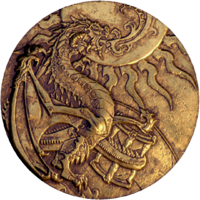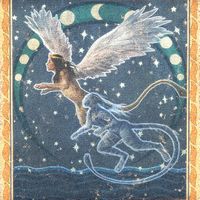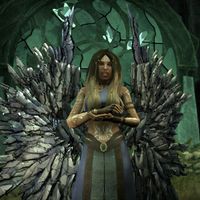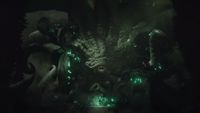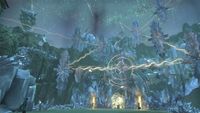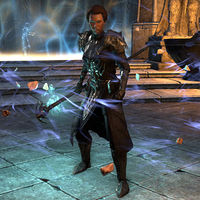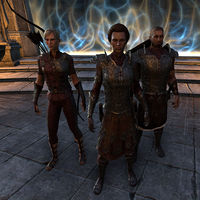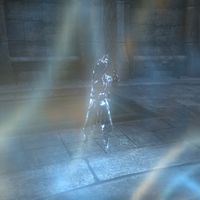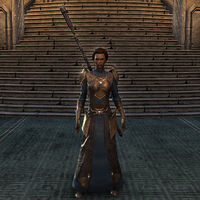Lore:Many Paths
| This page or section is incomplete. You can help by adding to it. Add new information from Gold Road and Scions of Ithelia For more information, see the help files, the style guide, and this article's talk page. |
—Amun-dro[1]
The Many Paths (also called the Many Paths of Fate or Many Paths of Time or alternate realities)[2][3] are the web comprised of the alternate realities and outcomes that arise from the possibilities of Aurbis. Possibilities scatter across the Aurbis, each defined by distinct choices and outcomes that lead to different realities. This web is called the Many Paths, which have been likened to both a spiderweb that formed within a diamond, interweaving lines within a grander fixed shape, and a halo of possibilities and alternate fates that surround reality. It is said that within the Many Paths all things are possible, things which might not be real in one reality might be real within the Paths, it is even possible to encounter realities where concepts such as magic or Daedra might not exist, or realities that are a dark reflection of the world, empty and timeless and filled with darkness, the world one sees when looking into a mirror. Each reality along the Many Paths contains its own version of each entity, be they mortal or Daedra, even deities such as the Daedric Princes have their own alternate versions within the realities. These alternate versions are said to be "reflections" of one another, different in some ways, like images in a cracked mirror, but originating from the same seed.[4][5][6]
In mythology, the Many Paths were formed when Akha explored the heavens and myriad kingdoms were created from his trails, and Alkosh and Khenarthi now safeguard the Many Paths from the "wayward children" of Akha.[1]
Contents
Mythology[edit]
In Khajiit mythology, when Ahnurr's Favored Son Akha explored the heavens, his trails became the Many Paths. In the earliest days, when Ahnurr and Fadomai were still in love, Ahnurr told him to find love the way he had with Fadomai. Akha mated with the Winged Serpent of the East, the Dune Queen of the West, and the Mother Mammoth of the North, before heading to the South and never returning. Instead, Alkosh appeared speaking warnings of the things Akha had made along the Many Paths. Inheriting the role and crown of the First Cat, Alkosh was granted rule over the myriad kingdoms of Akha along the Many Paths. In time, the children of Akha overthrew him and scattered his body on the West Wind. It is said that when Khenarthi learned this, she flew across the Many Paths and put Alkosh back together. In doing so, she saw all the things Akha had wrought, including those that should "not be". Now, Alkosh, his faithful, and Khenarthi safeguard the Many Paths from the wayward children of Akha, for they are both terrible and kind.[1]
A number of deities interact with the Many Paths in myth. Alkhan, the Firstborn of Akha, was slain by Lorkhaj and his companions, but as an immortal Son of Akha he will "return from the Many Paths in time".[1] It is said Boethra once walked the Many Paths in exile, and was followed back by the demon Orkha.[1][7] When Merrunz exiled was exiled by Ahnurr, he chose to explore the Great Darkness rather than the Many Paths and fell to the demon Molagh, who tortured him until the creation of the World.[7]
One pre Riddle'Thar Epiphany Khajiit account describes how, during the Middle-Dawn, Boethra was called from her battle with Orkha by the Blue Star and transported atop the Adamantine Tower by Khenarthi. There Boethra saw the Selectives speaking lies in a way that made them true, drawing runes that were attempting to make it so that neither Akha, nor Alkosh, nor Alkhan, nor any Child of Akha, nor any of the myriad kingdoms Akha had created along the Many Paths, any of the lands he'd seeded and brought into his kingdom, had ever existed. Seeing the lie the Selectives were attempting to make real, Boethra, who had once been exiled to the Many Paths by Akha, started to wander if she had ever been the Daughter of Blades at all, or if it had all been a dream of someone who'd never existed, and felt something akin to fear for the first time. Knowing the Selectives must not succeed, Boethra calculated and enacted the cuts needed to destroy both them and the lies they'd attempted to make real. Than, sensing an opportunity created by their actions, she found a tunnel to the fate they'd sought. Boethra opened her eyes to twelve spinning wheels surrounded by fire revolving beneath two warring serpents, one a serpent of flaming feathers and crystal scales with a head like a hunting bird, and another a crimson eyed serpent of blackest scales and a white mane followed by all the Void, the truth within the lies the Selectives had sought. The flame-feathered serpent emanated rejection of all "Mannish impurity in all the known worlds", the dark serpent though surrounded by chaos emanated gentleness and love for the spirits of the worlds, and in it Boethra saw a fleeting chance for peace along the wheels. As the feathered serpent's beak found purchase beneath the scales of the white maned serpent Boethra, dodging through the wheels to reach, summoned all her blades and struck at it's eye, repelling it. Landing on the head of the dark serpent she drew upon it's black flames, forming a blade and armor as her mind was scorched with things that were and have yet to be. She named the hawk-serpent for what it was and, reciting the Will Against Rule, dashed forward, cutting concepts at strange angles and ending the Dragon Break. This event would later come to be known as the Division of Heaven by mortals who remembered the Middle-Dawn.[2]
One Khajiit account describes how a Khajiit soul travels to Azurah's Crossing after death, and encounters Azurah herself. At that point the spirit remembers that it has lived and experienced the passage to the afterlife many times, and mentions it to Azurah. To this observation Azurah responds that the spirit has "walked many paths" to stand before her.[8]
Nature[edit]
The concept of the Many Paths is closely tied to the concept of fate. Indeed, they are also called the Many Paths of Fate.[2]
Described as the halo of possibilities and alternate fates that exists beyond and surrounding Aurbis, as well as the web which binds the possibilities scattered across Aurbis, each defined by unique choices and outcomes that lead to different realities, the Many Paths are said to lead everywhere. They are likened to a spiderweb that somehow formed within a diamond, interweaving lines within a grander fixed shape. Different possibilities and probabilities, places where fate takes a different course, potentials not yet realized, alternate realities both near and far, all these exist along the Many Paths and can be accessed by those who can traverse the connections. It is said that within the Many Paths all things are possible, things which might not be real in one reality might be real within the Paths, it is even possible to encounter realities where concepts such as magic or Daedra might not exist, or realities that are a dark reflection of Aurbis, empty and timeless and filled with darkness, the world one sees when looking into a mirror. Each reality along the Many Paths contains its own version of each entity, be they mortal or Daedra, even deities such as the Daedric Princes have their own alternate versions within the realities. These alternate versions are said to be "reflections" of one another, different in some ways, like images in a cracked mirror, but originating from the same seed.[5][4][6]
Alkosh, like Khenarthi, is said to be able to see across all the Many Paths.[3]
Access[edit]
Through an "umbric connection" (as coined by Azra Nightwielder), it is possible to link the shadows of beings together, allowing for telepathic communication over distance, although the process of such is painful.[9] Azra attempted to manipulate his own shadow to such an extent that he would meld all possible versions of himself from different realities, crossing over from a singular existence to all the existences in shadow. He was frozen for centuries following a battle with Redguard soldiers, so his experiment never came to fruition.[10]
The time-distorting properties of the Staff of Towers can be manipulated to alter the fabric of time and explore alternate realities. Through its use of changing the past, alternate versions of people from realities with different events can cross over to the main reality. This ability was discovered by Anumaril and recorded within his journals, and could be activated through a binding ritual performed in White-Gold Tower. The Psijic Josajeh sought to use the staff to erase drastic events in history such as her family's decline, the Knahaten Flu, Planemeld, and so on, and attempted the binding ritual in the Tower's throne room, bringing forth alternate versions of herself from different realities. Her ritual was interrupted and the Staff of Towers was reclaimed by the Psijics, preventing any further crossover.[11]
Azandar al-Cybiades attempted to peer beyond the veil of his reality, much as Hermaeus Mora does, to gaze upon other fatelines of paths unwalked. He discovered that different paths can branch out depending on the choices one makes, which are known as divergence points. Through his tampering of viewing alternate realities, frayed fates of his different lives formed in Fathoms Drift.[12]
As the Prince of Paths, the Daedric Prince Ithelia possesses the power to access the Many Paths, both through opening portals that allow for travel to other realities, and through pulling isolated elements from those other realities into the world or sending them back to their reality of origin. Ithelia's presence can cause the threads of fate and the Many Paths to converge in that location, causing "echoes" from other realities and gateways to parallel worlds to open there. This ability to access the Many Paths is shared to some extent by Ithelia's scions, who can banish others to the Many Paths. Certain locations originating from Ithelia's realm of Mirrormoor serve as gateways and points of convergence for the Many Paths. These include the Loom of the Untraveled Road, where any who linger may become lost in the Many Paths, and the mirrors surrounding Ithelia's prison, which can serve as gateways to the Many Paths provided one has the way to open them.[4][13][5][6]
Hermaeus Mora acquired the ability to open portals to the Many Paths after Ithelia showed him how to do so. In addition Mora can tap into the Many Paths directly to pull things from there into reality.[14][4][5]
The Lamp of Clarity was an artifact created by the Daedric Prince Azura. It possessed the power to illuminate the location of Ithelia and her servants in a given reality, and also to reveal and open portals to the Many Paths. The Lamp could both open gateways to the Paths so one could travel to different realities, and to pull elements from those different realities into one's own world, such as through allowing one to access the still functioning alternate version of an inactive portal or pulling alternate versions of important objects that one could no longer find in one's own world.[4][5][6]
The Many Paths and Ithelia[edit]
Ithelia is the Daedric Prince of Paths and Mistress of the Untraveled Road, who has the power to manipulate the Many Paths in order to alter fate.[14]
As the Prince of Paths, Ithelia can perceive all the Many Paths at once. Though she can't outright control the Many Paths, she can travel between them, or follow their threads and reach out to alter their fates. All alternate Ithelias across the Many Paths are connected to one another, a connection strengthened when Ithelia imbibes the Sage's Dream, a brew formed from the essence of many of her "reflections" from different Paths, which allows her to incorporate knowledge and power from them. Ithelia can also share her perception of the Many Paths with others, allowing them to briefly view the Many Paths as she herself does.[4][14][5]
Ithelia described the Many Paths variously as "possibilities, probabilities, places where fate takes a different course", "possibilities not yet realized", "realities close and distant", and "possibilities, roads to different outcomes, different realities". Additionally, she declared that "in the Many Paths, all things are possible", even to the point of extending beyond the foreseeable fates before the Daedric Prince Hermaeus Mora.[4]
During a journey through different realities of the Many Paths, an alternate version of Ithelia explained that each of her "reflections" are connected, and can stabilize this connection with the Sage's Dream, a drink made from the essences of each reflection. The drink can reintegrate each Ithelia with her reflections, stabilizing her and allowing each to share their power and understanding through a combined essence. Furthermore, this alternate Ithelia explained the Many Paths as the web that binds the possibilities scattered across the Aurbis, each defined by distinct choices with unique outcomes that lead to new realities. Each of these realities contains a version of an entity, mortal or Daedra, with these versions differing in some way from each other but springing from the same seed. The Many Paths could potentially connect each of these versions across all realities, as it has in the case of Ithelia herself. The Prince has the ability to see the paths, follow their threads, and alter their fates. This ability has allowed Ithelia to prevent disasters to reality, but it also could threaten the very existence of that reality as well. This threat to reality that Ithelia's power posed came to terrible fruition in one of the alternate realities visited by the Vestige, where that reality's Ithelia, enraged by the other Princes' attempts to imprison her, became the prophesized Last Tomorrow and shredded that whole reality to nothing.[15][16][4]
Using the Loom of the Untraveled Road, a series of portals within portals leading to the Many Paths, Ithelia had the power to reshape reality and the fates and change history, taking alternate fates from the Many Paths and weaving them into reality to replace the history that exists. By weaving the different threads of the Many Paths, Ithelia attempted to weave into reality a history where she was never in conflict with the other Princes and so was never imprisoned. Ithelia's ultimate goal prior to her imprisonment was to use the Loom to give each being their own desired history, granting everyone unconstrained choice and making it so no being was bound by the constraints of fate.[17]Fearing that Ithelia's unnatural manipulations, which had already caused the Many Paths to splinter, would lead to the end of reality, Hermaeus Mora and three allied Daedric Princes took action to imprison her.[14] After the Loom was destroyed, Ithelia was "filled with the power of the Many Paths" and, overwhelmed by the untold power, became the Last Tomorrow, the Destroyer of Reality and the threat Hermaus Mora had predicted. As she attacked Hermaeus Mora and Apocrypha in an attempt to take control of the realm and transform it into a new Mirrormoor, she was unraveling the threads of fate, causing rips in reality that would have multiplied and grown until they erased all of existence. Fortunately, Ithelia was shown the truth and she dissipated the power of the Many Paths before she could destroy reality.[18][4][5][13][16]
After the close call with Ithelia, one more facet of the Many Paths was revealed. Upon the recommendation of Fate's Chosen, Hermaeus Mora and Ithelia searched the Many Paths for a universe where Ithelia would have no power. It was shown that Many Paths don't just lead to alternate realities, but "everywhere, other possibilities, parallel realities, one can go anywhere if they can find the right path". A world was found where Daedra and Magicka itself did not exist, and Ithelia was banished there never to return.[19][14][4]
The Many Paths and Hermaeus Mora[edit]
Hermaeus Mora, like Ithelia, can perceive the Many Paths, and is even able to locate specific realities with the qualities he's looking for within them. As Ur-Daedra and the One Who Knows, Hermaus Mora is said to be able to see all the infinite paths of possibility arrayed before his gaze, though even he can't always see the "final path". Mora acquired the ability to open portals to other realities accessible through the Many Paths after Ithelia showed him how to do so. Through tapping into the possibilities of the Many Paths, Mora also possesses the seeming ability to restore to existence individuals who were erased via contact with a reality tear, though the Vestige theorized he might have simply pulled an alternate version of the erased individual from the Many Paths to give the impression he restored the original instead.[14][4][5]
Artifacts[edit]
The Loom of the Untraveled Road[edit]
A Daedric apparatus of unimaginable power said to be what Hermaeus Mora feared, leading to him taking action against Ithelia. Described as a series of portals within portals leading to the Many Paths, it is more of a place than an engine, residing within a pocket dimension within Fargrave. With the Loom Ithelia is said to be able to reshape the fates, accessing alternate fates and histories from the Many Paths and weaving them into reality, or even granting each being their own desired history to break fate's shackles. Places that were part of Mirrormoor are said to be fundamentally connected to the Loom, and artifacts used in such locations will have their power drained by the Loom as it gains power. Through the Loom Ithelia can also draw immense amounts of power from the Many Paths, though the untold amounts of energy ultimately overwhelm her, transforming her into the Last Tomorrow, the threat Hermaeus Mora foresaw. Even after being destroyed through the use of Boethiah's Blade, Abolisher, the Loom still radiates power, preventing approach through portal magic and making the area around the Loom itself unstable, threatening anyone lingering there with the possibility of becoming lost in the Many Paths.[4][5][13][16]
Abolisher[edit]
An artifact created by the Daedric Prince Boethiah to aid in Ithelia's imprisonment. It held the power to open portals, destroy them, or reopen sealed portals. In addition it could be used to sever the link the Many Paths provided to a different reality, rendering it inaccessible.[4][14][5][6][20] Abolisher was ultimately destroyed when it was used as part of a spell originating from Hermaeus Mora, which was provided to the Vestige in order to repair the reality tears created by Ithelia's power that were threatening to unravel all existence. After the spell was cast Abolisher became a normal sword, its Daedric power fully expended.[21]
The Lamp of Clarity[edit]
An artifact created by the Daedric Prince Azura in order to aid in Ithelia's imprisonment. It possessed the ability to illuminate the presence of Ithelia and her Unseen on a Path and to reveal and open portals to the Many Paths, or pull alternate versions of things from the Many Paths into reality.[4][5][6] The Lamp was ultimately destroyed when it was used as part of a spell originating from Hermaeus Mora, which was provided to the Vestige in order to repair the reality tears created by Ithelia's power that were threatening to unravel all existence. After the spell was cast the Lamp of Clarity became a normal lamp, its Daedric power fully expended.[21]
Gallery[edit]
Notes[edit]
- The term multiverse has been used as well, though multiversal travel often refers to realms solely within the Aurbis, while the Many Paths go beyond that.[22][23]
- It is said that due to the Soulburst, Nirn had become unmoored from the fabric of the multiverse.[UOL 1]
- It is said that characters and objects from The Elder Scrolls are brought into the worlds of other games (such as Fortnite) and vice versa (such as The Legend of Zelda and Portal),[24][25] but the exact specifics of how this happens is not expanded upon.
References[edit]
- ^ a b c d e The Wandering Spirits — Amun-dro, the Silent Priest
- ^ a b c The Bladesongs of Boethra, Volume V — Modun-Ra, the Hidden Voice
- ^ a b Ja'darri's dialogue in ESO: Dragonhold
- ^ a b c d e f g h i j k l m n Ithelia's dialogue in ESO
- ^ a b c d e f g h i j k Leramil's dialogue in ESO
- ^ a b c d e f Beragon's dialogue in ESO
- ^ a b The Adversarial Spirits — Amun-dro, the Silent Priest
- ^ Azurah's Crossing — Amun-dro, the Silent Priest
- ^ Azra Nightwielder's dialogue in Shadowkey
- ^ Second Scroll of Shadow
- ^ Josajeh's dialogue in ESO: Summerset
- ^ Azandar al-Cybiades' dialogue in ESO: Necrom
- ^ a b c Shardmarshal Vargas' dialogue in ESO
- ^ a b c d e f g Hermaeus Mora's dialogue in ESO
- ^ Interactions with Alternate Ithelias in ESO
- ^ a b c Torvesard's dialogue in ESO
- ^ Events of The Untraveled Road in ESO: Gold Road
- ^ Events of ESO: Gold Road
- ^ Events of Fate of the Forgotten Prince in ESO: Gold Road
- ^ Tribune Alea Idolus' dialogue in ESO
- ^ a b Scruut's dialogue in ESO
- ^ Luna Beriel's dialogue in ESO
- ^ Sotha Sil's dialogue in ESO: Summerset
- ^ Battle for Brutal Bastion with These ESO-Themed Fortnite Items - ESO
- ^ Amiibo power in Skyrim Switch Edition
Note: The following references are considered to be unofficial sources. They are included to round off this article and may not be authoritative or conclusive.
